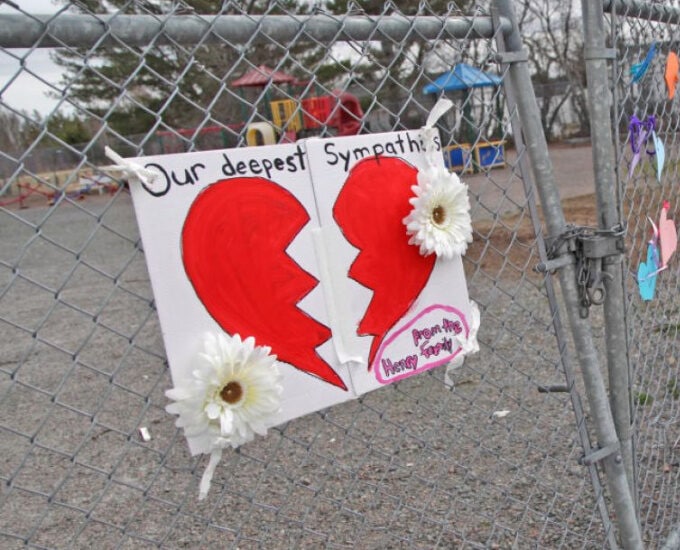
KJIPUKTUK (Halifax) – Many people are now realizing that the murder rampage by the Dartmouth denturist GW, who shot 22 Nova Scotians dead, did not begin as a simple “domestic.”
A “domestic” is a euphemism the police often use instead of using the term “intimate partner violence”. The police believed a domestic was the “catalyst” which caused the 51-year-old denturist, GW, to massacre people from several small communities within 100 km of Portapique, in central Nova Scotia.
Did a “domestic” argument fire up the mass killer? Really – how can that be? Surely the sheer number of murders – some deliberate and some random — the blood shed, the houses and cars set ablaze couldn’t be the result of one “domestic.”
RCMP Superintendent Darren Campbell said at a media briefing that GW’s argument with his woman partner could have been a “catalyst to start the chain of events”. According to the woman, GW confined, beat and injured her. She then fled for her life and hid in the woods overnight. Superintendent Campbell has now walked that comment back, but not in a good way. He insists that the cops can’t or won’t find a link to misogyny in the “events” – since not all the victims were female.
On the Sunday following the shootings in Nova Scotia, Michael Enright, host of the CBC Radio One flagship program “The Sunday Edition”, twice stated that the killer was “crazy.” Many remember the mainstream media’s insistence — 31 years ago –that Marc Lépine, who shot 14 women to death at the École Polytéchnique in Montréal was also “crazy”. However, crazy doesn’t cut it.
In the Nova Scotia massacre, 60% of the victims were women, some were killed at home alongside their male partners, or were women living on their own. One woman was taking a walk Sunday morning; one was a single mother at home, two were nurses driving to work in their cars. The Globe and Mail reported that police found a partial list of the shooter’s targeted victims among the charred ruins of his burned out property in Portapique. In fact, Nathan Staples, who lives in a village 15 minutes’ drive from Portapique, was on the list. Staples said he could only think of one time he had any dealings with GW, the killer. Months ago Staples had refused to sell him an old police cruiser.
The police admit the killer had to have planned his rampage, but they have no idea what length of time the killer prepared. I can suggest something on that. About six weeks ago, due to dangers presented by the Covid-19 virus, the government asked Nova Scotia dentists to close their offices to patients. My guess is GW, a denturist, faced the same request to close his office. The killer possibly had more than five weeks to sit at home and finalize his murder plan.
What happened in the Nova Scotia killings case bears some similarities to the 2017 murders committed by Lionel Desmond, which also took place in rural Nova Scotia. On January 3, 2017, Desmond, a 33-year-old African-Nova Scotian, who had served as a sniper in Canada’s infantry, killed his wife Shanna, their 10-year-old daughter Aaliyah, and his 52-year-old mother, Brenda. Then he took his own life. The murders shook the province and the nation. Some suggested that Desmond’s actions resulted from Post-traumatic stress disorder (PTSD), which stemmed from two tours of military service in Afghanistan in 2007.
More and more, the powerful and the public wanted to believe that it was PTSD that was the prime mover behind Desmond’s murders. Indeed, his obituary read, in part, that he had “succumbed to the tortures of PTSD.”
About a week after the murders, Dr Ardath Whynacht, a sociology professor at Mt Allison University, suggested, “we look at the trends in intimate partner violence… a woman is killed by an intimate partner once every six days in Canada.”
She went on to say “… we have to ask the question: Why didn’t he [Desmond] just take his own life? Where in his life did he learn that it was up to him to take the lives of the three women he was most close to? That’s not a question that we’ll be able to answer by looking at PTSD … We can’t ignore the role of family violence here.”
For merely questioning the dominant narrative that Desmond’s PTSD caused him to commit the crimes, Dr Whynacht faced a storm of death and rape threats and harassment by internet trolls.
She wasn’t the only one who doubted the dominant narrative. Gail Lethbridge, a columnist for the Halifax Chronicle Herald, wrote four days after the killings:
“Family and friends have said he [Desmond] was suffering from his wartime experiences… But let’s not forget that this was also a brutal act of domestic violence and take whatever facts we can from the Desmond tragedy to understand that, and to use it as an opportunity to address the massive problem of family violence.”
In fact, a 2016 federal government publication, “Focus on Family Violence in Canada”, reported that more than 760,000 or 4% of Canadians over age 15, admitted that they had experienced intimate partner violence in the last five years. Justice Canada found that the cost of domestic violence is $7.4 billion per year. That number includes police, counselling, health care, court time, lawyers and lost wages.
Still some experts weighed in to underscore the pre-eminence that PTSD had played in the Desmond murders, and his suicide. Among them was Rev. Elaine Walcott, a relative of the Desmonds and a spiritual advisor. She rejected domestic violence as a factor. “It’s a perspective that is extremely damaging.” She said that shifting the blame to domestic violence would only succeed in perpetuating stereotypical images and pitting members of the black community against each other.
In June 2017, five months after the deaths, Gail Lethbridge was the first columnist to call for a public inquiry. As she put it
“…Does PTSD lead a sufferer to such actions in the first place? No, it does not. So what happened here?
….For the life of me, I cannot understand why Nova Scotia’s medical examiner is holding back on conducting a public investigation into why a man walked into his house and murdered his wife, daughter and mother, before taking his own life.”
That same month, Lionel Desmond’s two sisters demanded an inquiry. In October, the women travelled to Parliament to publicize the need for an inquiry. Their demands were echoed by others, yet the McNeil government and NS’s chief medical examiner Matt Bowes ignored them for a year. A whole year passed before McNeil called a public inquiry.
Some have suggested that the premier balked at calling a public inquiry because of its cost. Perhaps the federal government finally pitched in some money for the inquiry since at least some of the blame for the killings had been ascribed to Desmond’s mental health difficulties which flowed from his military service.
In 2020, three years after the murders, the inquiry began. And it was extremely informative. From January until early February, there were almost daily media reports from the Desmond inquiry. They revealed a lot about the circumstances leading to Desmond shooting his family and himself.
It was testimony at the inquiry that reveals some resemblance between killers Desmond and GW. For example, Desmond and his wife Shanna had argued on January 1, 2017. Accidentally, he had run her new vehicle into a ditch on the family’s way home from a party. His shame and anger turned into a major argument with Shanna. The argument was intensifying, so she told him to leave their house later in the evening. He did leave. For her part, in the fall of 2016, she had been considering divorce and had spoken about leaving him.
We don’t have a very clear picture of what happened in the lead up to the Portapique shootings. We do know that the police insisted at the outset that a domestic argument – that began when GW and his partner were at a neighbour’s house party (during Covid?) and carried on when they got home had sparked his rage and the shootings. Perhaps she had threatened to leave GW.
However the police’s position that a domestic argument sparked GW’s murder rampage was shortlived. Within the week, feminists and their supporters argued that the police were blaming the partner, who was in fact the victim of physical abuse. Also, the police had dared to say a disagreement or argument was a precipitating factor in the killings demonstrated the police had little time for the idea that GW sought the power of the police and used a police uniform and mock cruisers in an elaborate murder plan. After ten days the police withdrew their remark about attributing the murders to the domestic argument, but the damage had been done.
Here is a list of other similarities in the two cases:
| Desmond | GW |
| An argument, ostensibly about him driving his wife’s car into a ditch, led to anger after a party, led to possible violence in the home and his wife’s demand for him to leave the house that night. He returned 40 hours later to commit murders | An argument at a party continued at home; led to violent assault, injuries and tying up of partner. She escaped and hid overnight. He left the house and then set it on fire. |
| Stockpiled at least 3 rifles weapons and purchased and used a semi-automatic rifle on the day of the murders. All legal weapons | Stockpiled weapons; used a semi-automatic. Unknown how many weapons he owned; probably not licensed |
| Evidence the attack was planned | Evidence the attacks were planned |
| “A respectful guy” | “A good neighbour, very kind” |
| Police claim: An argument with his wife around a car in the ditch set off the chain of events | Police claim: Argument with partner set off the chain of events |
| Former n\sniper, infantryman | Fixated by military, and power (he owned 4 mock RCMP cars) |
| Changed into a military style camouflage outfit to commit murders | Changed into an RCMP outfit to commit some of the murders |
| Shot people he knew in their home | Shot some people in their homes |
| Shot with semi automatic—legal weapon | Shot with semi automatic—unlicensed firearms |
| In 2015, police had him hospitalised because he threatened suicide. | Police charged GW with assault of a teenager 18 years ago, he had had other run-ins with police |
| Killed 2 women and 1 girl. | Killed 12 women, 1 girl |
The RCMP set the tone for the investigation, and any upcoming inquiry.
Historically, the RCMP refuses to see some criminal behaviour, especially attacks on women and children, through a feminist lens. To say they cannot see what is staring them in the mirror is an understatement. Since 2007, more than 3130 women, former RCMP officers and civilian employees, have filed in a class action lawsuit against the RCMP for sexual harassment and discrimination. To date the RCMP has had to pay out more than $200 million*.
The RCMP still speaks about “domestic violence” as a set of one-off incidents. It’s time that the public demand more from the RCMP when they deal with these horrible crimes against women and children.
While many circumstances lead to men shooting and killing women – investigating them through the feminist lens is necessary. It’s a matter of life and death.
—
*3130 women represents nearly 10% of the current 30,000 RCMP employees. Since only 21.5% of the 30,000 are women, almost half of the women attached to the RCMP were part of the lawsuit.
See also: Let’s call the Nova Scotia mass shooting what it is: White male terrorism
Judy Haiven is on the steering committee of Equity Watch, a Halifax-based organization which fights bullying, racism and discrimination in the workplace. You can reach her at equitywatchns@gmail.com
With a special thanks to our generous donors who make publication of the Nova Scotia Advocate possible.
Subscribe to the Nova Scotia Advocate weekly digest and never miss an article again. It’s free!




Who changes into combat fatigues before committing suicide ? Lots of men apparently. Many men-who-kill-their-families along with many men-who-kill-anyone-in-their-gunsights.
In their addled brains, the uniform helps convince themselves they are some sort of avenging angel of death, dealing justice with cartridges & bullets.
We need to widen our view of what constitutes a murder-suicide and treat it for what it is : a murder. Murder that runs from killing one person, usually a family member, through to killing extended families or the people they worked with , to anyone in the way of a spree killer.
A spree killer is always at least a potential suicide by cop and we should tie their behavoir to the murder-suicides much less studied – indeed buried by media.
Often do we hear police spokespeople describe a murder-suicide as a “family tragedy” and then not offer up any more investigation : case closed.
No : someone was murdered and the mere death of their killer shouldn’t end society’s investigation into whether it could have been prevented…